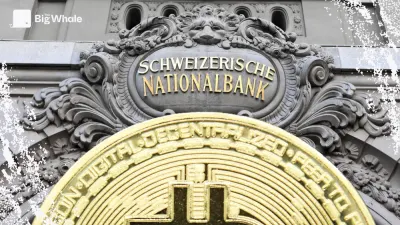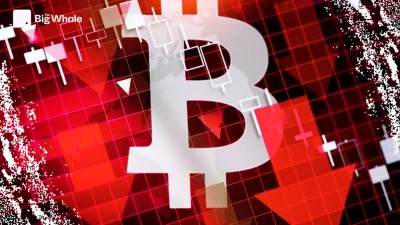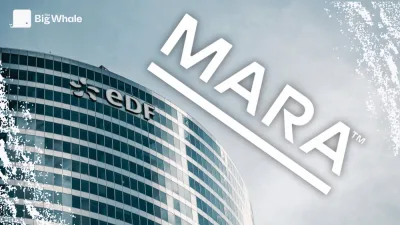TBW - Paul Brody (EY): "Every bank will launch its own stablecoin"
"Every bank will launch its own stablecoin"

The Big Whale: To start simply, what do you see as the biggest trend for 2025? Is it more about institutional adoption or tokenisation?
Paul Brody: The biggest trend of 2025 will really be the blurring of the differences and gaps between traditional banking and the blockchain ecosystem.
This is happening at both the consumer and business level. It's a trend that's been building for a while, but we're approaching a critical point where it's really going to impact customers.
Let's take two concrete examples. On the consumer side, the integration of crypto wallets and traditional payment systems is reaching a level where the user will no longer differentiate between a traditional banking application and a crypto application.
We're not quite there yet, but we're getting close. For example, it only took me 15 minutes to link my MetaMask wallet to a MasterCard that can be used on Apple Pay. Sure, the user interface could still be improved, but the sign-up process was relatively straightforward.
On the other hand, at the corporate level, we're seeing the same kind of evolution. Last year, EY was the first company to receive a B2B payment in stablecoin PYUSD from PayPal. What was unprecedented was that this time the transaction was fully automated thanks to our collaboration with PayPal, SAP and Coinbase.
Previously, each transaction required manual intervention by our accounting department. Now, PayPal can pay an EY invoice directly from its SAP system, and the sum automatically appears in our Coinbase account, just like a conventional bank payment.
This type of transaction has increased in number. What's the second step?
Once automation is in place, a company can simply set a rule in its accounting software stating that, if a crypto address is available, payment will be made via crypto rails rather than traditional banking systems.
According to our calculations, if we could convert all of our payments to crypto (which is not yet possible due to regulatory restrictions on cross-border payments), we would save around $100 million a year at EY.
You have recently explained several times that the activity around blockchain. What do you mean by this? Are you talking about the sector or EY?
There is significant growth for both. In 2023, the European market has been particularly buoyant thanks to the introduction of MiCA, which has provided a clear regulatory framework, encouraging companies to invest.
Since last November, we have seen a surge of interest in the US, as companies anticipate greater regulatory clarity and prepare accordingly.
What are the main use cases generating this increased demand?
Three words: stablecoins, stablecoins and stablecoins.
Everyone wants to use them, issue them and integrate them into their operations. Above all, they have become a must-have for financial players.
With each technological transition, the first users are often the most profitable customers. Today, some of the best banking customers are starting to use crypto services. Banks do not want to lose these customers and are therefore looking to enter this market.
In fact, we are seeing a convergence between banks and crypto companies. Banks are starting to offer services in ETH, Bitcoin and tokenised assets, while crypto companies are starting to look like banks by offering deposits and stablecoins at a return.
Just in the stablecoin market, we're seeing that the adoption of USDT and USDC seems almost definitive. Do you think the distribution battle is over?
That's an open question. It all depends on your view: do you see crypto primarily as a financial industry or a technology industry?
If it's a technology industry, then yes, it may be difficult to dethrone established leaders. But if it's a financial industry, then the competition remains fierce. Decentralised marketplaces such as Uniswap have seen their market share drop from almost 100% to less than 20%, proving that nothing is set in stone.
Do you think banks will issue their own stablecoins?
Yes, without a doubt, I think all the banks will launch their own stablecoins, and that will allow us to see whether it's essential to have your own asset or whether it's enough to use those that already exist.
Will these stablecoins be used primarily as a means of payment or as a savings product?
Probably both. A stablecoin can function as a deposit account. Banks that don't issue them risk losing deposits to those that do.
The Big Whale: In Europe, regulations prohibit returns on stablecoins. Do you think this could slow down their adoption?
This is a key question. In discussions with the ECB and other European regulators, we sense an awareness of the current limitations and a rethink is underway.
If interest rates return to zero, the yield issue will become secondary, but if not, regulatory adjustments will probably be needed to ensure the competitiveness of stablecoins in Europe.
The Big Whale: There's a lot going on in Argentina in terms of cryptos. What do you think of the dynamics there?
In Argentina, the use of cryptos is totally different to what we see in Europe or the United States. Over there, it's not a question of meme coins, but only stablecoins.
Argentines mainly use stablecoins in dollars and Bitcoin, often via DeFi on Ethereum. It's a very pragmatic approach to an unstable economy.
Do you think that in five or ten years' time, the crypto ecosystem will be reduced to Bitcoin, Ethereum and dollar stablecoins?
Yes, to a large extent. One of the key messages I give our clients is simple: Bitcoin is the asset, Ethereum is the platform. For the rest, it's pretty much over. All these alternative level 1 blockchains (Alt L1) have very little chance of surviving in the long term.
An interesting phenomenon with the crypto market is that, unlike traditional businesses, blockchains in trouble do not disappear immediately.
In a traditional business, when a company accumulates losses but still holds cash, shareholders demand a return on investment or liquidation. In crypto, many of these blockchains are supported by foundations that are not subject to this pressure. They therefore continue to exist even if their long-term future is almost sealed.
Besides, I'm not naming any more names, because every time I've done so, the managers of these blockchains have tried to put pressure on EY, even going so far as to contact our chairman at a weekend to complain about my comments on X!
What excites you most about Ethereum today?
Many aspects. First of all, neutrality is essential. We recently had a reminder of its importance when an alternative blockchain released a shocking advert, which they withdrew within a few hours (Solana, editor's note).
Next, Ethereum is the most dynamic ecosystem. With more than 50 layer 2s (L2s), we're starting to see a specialisation of these L2s. This attracts the best talent and most of the liquidity. A good example is Celo, which has just transitioned from an independent L1 blockchain to an Ethereum L2, and whose business is exploding thanks to this transition.
Finally, Ethereum's transaction capacity has increased hundreds of times over with the rise of L2s, dramatically reducing transaction costs. Some people complain about the price of ETH, but the reality is that businesses want low and predictable fees. In the long term, the network's capacity will be fully exploited.
Do you think the fragmentation of L2s could harm liquidity on Ethereum?
Not at all. Interoperability between Ethereum L2s will be much stronger than that between Ethereum and other ecosystems. I don't think it will lead to any problematic fragmentation.
What surprises me is that we haven't yet seen governments launch their own national L2. I've spoken to many politicians and recommended that they create country-specific L2s, because it would make a lot of sense for them.
And for companies, can you imagine a company like BlackRock launching its own L2?
For an investment company, maybe. But an industrial company like General Motors creating its own L2? Not a good idea. The whole point of blockchain is to operate in an interoperable ecosystem. Competitors will never want to pay transaction fees on an infrastructure controlled by a rival.
Everyone is talking about tokenisation. How do you see it being adopted?
There are three types of tokenisable assets:
First, there is cash and liquid instruments (cash, treasury bills, etc.): these are almost stablecoins, and large companies are not destined to become banks.
Then there are financial securities already traded on the stock market: the question here is why tokenise them? To increase liquidity? To maximise returns? There has to be real added value.
Finally, there are illiquid assets: this is where the greatest potential lies. Imagine being able to tokenise Thai real estate and make it accessible to Californian pension funds. It takes time, because you need to accumulate data over several years to prove to institutional investors that it's a viable investment.
The bulk of the world's capital is held by pension funds and sovereign wealth funds. For them to invest massively in tokenised assets, the latter must go through a rigorous academic and regulatory validation process.Ethereum continues to be the central hub of blockchain innovation, while Bitcoin remains the benchmark asset.
Most alternative blockchains are struggling to justify their existence in the face of this consolidated ecosystem. As for the tokenisation of real assets, this offers considerable potential, but will require several more years of maturation before it appeals to the largest institutional investors.



